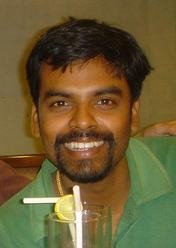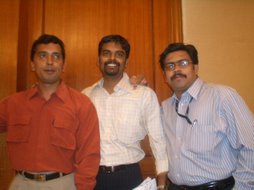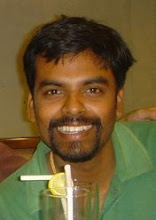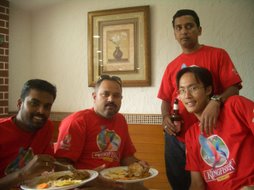The election of Bobby Jindal as governor of the US state of Louisiana has been greeted exultantly by Indians and Indian-A m e r i c a n s around the world. There’s no question that this is an extraordinary accomplishment: a young Indian-American, just 36 years old, not merely winning an election but doing so on the first ballot by receiving more votes than his 11 rivals combined, and that too in a state not noticeably friendly to minorities. Bobby Jindal will now be the first Indian-American governor in US history, and the youngest currently serving chief executive of an American state. These are distinctions of which he can legitimately be proud of. But is our pride misplaced? Who is Bobby Jindal and what does he really stand for? There are, broadly speaking, two kinds of Indian migrants in America: though no sociologist, i’ll call them the atavists and the assimilationists. The atavists hold on to their original identities as much as possible, especially outside the workplace; in speech, dress, food habits, cultural preferences, they are still much more Indian than American. The assimilationists, on the other hand, seek assiduously to merge into the American mainstream; they acquire a new accent along with their visa, and adopt the ways, clothes, diet and recreational preferences of the Americans they see around them. (Of course, there are the in-betweens, but we’ll leave them aside for now.) Class has something to do with which of the two major categories an Indian immigrant falls into; so does age, since the newer generation of Indians, especially those born in America, inevitably tend to gravitate to the latter category. Bobby Jindal is an assimilationist’s dream. Born to relatively affluent professionals in Louisiana, he rejected his Indian name (Piyush) as a very young child, insisting that he be called Bobby, after a (white) character on the popular TV show ‘The Brady Bunch’. His desire to fit in to the majority-white society he saw around him soon manifested itself in another act of rejection: Bobby spurned the Hindusim into which he was born and, as a teenager, converted to Roman Catholicism, the faith of most white Louisianans. There is, of course, nothing wrong with any of this, and it is a measure of his precocity that his parents did not balk at his wishes despite his extreme youth. The boy was clearly gifted, and he soon had a Rhodes scholarship to prove it. But he was also ambivalent about his identity: he wanted to be seen as a Louisianan, but his mirror told him he was also an Indian. The two of us won something called an ‘Excelsior Award’ once from the Network of Indian Professionals in the US, and his acceptance speech on the occasion was striking — obligatory references to the Indian values of his parents, but a speech so American in tone and intonation that he mangled the Indian name of his own brother. But there are many ways to be American, and it’s interesting which one Bobby chose. Many Indians born in America have tended to sympathise with other people of colour, identifying their lot with other immigrants, the poor, the underclass. Vinita Gupta, in Oklahoma, another largely white state, won her reputation as a crusading lawyer by taking up the case of illegal immigrants exploited by a factory owner (her story will shortly be depicted by Hollywood, with Halle Berry playing the Indian heroine). Bhairavi Desai leads a taxi drivers’ union; Preeta Bansal, who grew up as the only non-white child in her school in Nebraska, became New York’s Solicitor General and now serves on the Commission for Religious Freedom. None of this for Bobby. Louisiana’s most famous city, New Orleans, was a majority black town, at least until Hurricane Katrina destroyed so many black lives and homes, but there is no record of Bobby identifying himself with the needs or issues of his state’s black people. Instead, he sought, in a state with fewer than 10,000 Indians, not to draw attention to his race by supporting racial causes. Indeed, he went well beyond trying to be non-racial (in a state that harboured notorious racists like the Ku Klux Klansman David Duke); he cultivated the most conservative elements of white Louisiana society. With his widely-advertised piety (he asked his Indian wife, Supriya, to convert as well, and the two are regular churchgoers), Bobby Jindal adopted positions on hot-button issues that place him on the most conservative fringe of the Republican Party. Most Indian-Americans are in favour of gun control, support a woman’s right to choose abortion, advocate immigrants’ rights, and oppose school prayer (for fear that it would marginalise non-Christians). On every one of these issues, Bobby Jindal is on the opposite side. That hasn’t stopped him, however, from seeking the support of Indian-Americans. Bobby Jindal has raised a small fortune from them, and when he last ran (unsuccessfully) for governor in 2004, an army of Indian-American volunteers from outside the state turned up to campaign for him. Many seemed unaware of his political views; it was enough for them that he was Indian. At his Indian-American fundraising events, Bobby is careful to downplay his extreme positions and play up his heritage. Indian-Americans, by and large, accept this as the price of political success in white America: it’s just good to have “someone like us” in such high office, whatever views he professes to get himself there. So Indians beam proudly at another Indian-American success story to go along with Kalpana Chawla and Sunita Williams, Hargobind Khorana and Subramaniam Chandrasekhar, Kal Penn and Jhumpa Lahiri. But none of these Indian Americans expressed attitudes and beliefs so much at variance with the prevailing values of their community. Let us be proud that a brown-skinned man with an Indian name has achieved what Bobby Jindal has.
(Courtesy - ShashiTharoor, Times of India)
Monday, October 29, 2007
The Sensex story: From 1K to 20K
It was a terrific day for the Indian markets. The Sensex conquered the 20,000-mark on the back of frantic buying by foreign and local investors in blue-chip stocks. The Sensex made history after it hit an all-time intra-day high of 20,024.87 points during the last five minutes of trading on Monday.The index took only 10 days to gain 1,000 points after it crossed the 19,000-mark on October 15.
The major drivers of Monday's rally were index heavyweights Larsen and Toubro, Reliance Industries , ICICI Bank, HDFC Bank and SBI among others.
With today's landmark, Sensex has joined the 20,000-point club, whose other members are Hong Kong's Hang Seng, Brazil's Bovespa and Mexico's Bolsa among others.The Sensex crossed three milestones in October as it breached the 18K on October 9, 19K on October 15 and 20K today!
(See below for the timeline)
Following is the timeline on the rise and rise of the Sensex through Indian stock market history.
1000, July 25, 1990
On July 25, 1990, the Sensex touched the magical four-digit figure for the first time and closed at 1,001 in the wake of a good monsoon and excellent corporate results.
2000, January 15, 1992
On January 15, 1992, the Sensex crossed the 2,000-mark and closed at 2,020 followed by the liberal economic policy initiatives undertaken by the then finance minister and current Prime Minister Dr Manmohan Singh.
3000, February 29, 1992
On February 29, 1992, the Sensex surged past the 3000 mark in the wake of the market-friendly Budget announced by the then Finance Minister, Dr Manmohan Singh.
4000, March 30, 1992
On March 30, 1992, the Sensex crossed the 4,000-mark and closed at 4,091 on the expectations of a liberal export-import policy. It was then that the Harshad Mehta scam hit the markets and Sensex witnessed unabated selling.
5000, October 8, 1999
On October 8, 1999, the Sensex crossed the 5,000-mark as the BJP-led coalition won the majority in the 13th Lok Sabha election.
6000, February 11, 2000
On February 11, 2000, the infotech boom helped the Sensex to cross the 6,000-mark and hit and all time high of 6,006.
7000, June 20, 2005
On June 20, 2005, the news of the settlement between the Ambani brothers boosted investor sentiments and the scrips of RIL, Reliance Energy, Reliance Capital , and IPCL made huge gains. This helped the Sensex crossed 7,000 points for the first time.
8000, September 8, 2005
On September 8, 2005, the Bombay Stock Exchange's benchmark 30-share index -- the Sensex -- crossed the 8000 level following brisk buying by foreign and domestic funds in early trading.
9000, November 28, 2005
The Sensex on November 28, 2005 crossed the magical figure of 9000 to touch 9000.32 points during mid-session at the Bombay Stock Exchange on the back of frantic buying spree by foreign institutional investors and well supported by local operators as well as retail investors.
10,000, February 6, 2006
The Sensex on February 6, 2006 touched 10,003 points during mid-session. The Sensex finally closed above the 10K-mark on February 7, 2006.
11,000, March 21, 2006
The Sensex on March 21, 2006 crossed the magical figure of 11,000 and touched a life-time peak of 11,001 points during mid-session at the Bombay Stock Exchange for the first time. However, it was on March 27, 2006 that the Sensex first closed at over 11,000 points.
12,000, April 20, 2006
The Sensex on April 20, 2006 crossed the 12,000-mark and closed at a peak of 12,040 points for the first time.
13,000, October 30, 2006
The Sensex on October 30, 2006 crossed the magical figure of 13,000 and closed at 13,024.26 points, up 117.45 points or 0.9%. It took 135 days for the Sensex to move from 12,000 to 13,000 and 123 days to move from 12,500 to 13,000.
14,000, December 5, 2006
The Sensex on December 5, 2006 crossed the 14,000-mark to touch 14,028 points. It took 36 days for the Sensex to move from 13,000 to the 14,000 mark.
15,000, July 6, 2007
The Sensex on July 6, 2007 crossed the magical figure of 15,000 to touch 15,005 points in afternoon trade. It took seven months for the Sensex to move from 14,000 to 15,000 points. 16,000, September 19, 2007The Sensex scaled yet another milestone during early morning trade on September 19, 2007. Within minutes after trading began, the Sensex crossed 16,000, rising by 450 points from the previous close. The 30-share Bombay Stock Exchange's sensitive index took 53 days to reach 16,000 from 15,000. Nifty also touched a new high at 4659, up 113 points. The Sensex finally ended with its biggest-ever single day gain of 654 points at 16,323. The NSE Nifty gained 186 points to close at 4,732. 17,000, September 26, 2007The Sensex scaled yet another height during early morning trade on September 26, 2007. Within minutes after trading began, the Sensex crossed the 17,000-mark . Some profit taking towards the end, saw the index slip into red to 16,887 - down 187 points from the day's high. The Sensex ended with a gain of 22 points at 16,921.
18,000, October 09, 2007The BSE Sensex crossed the 18,000-mark on October 09, 2007. It took just 8 days to cross 18,000 points from the 17,000 mark. The index zoomed to a new all-time intra-day high of 18,327. It finally gained 789 points to close at an all-time high of 18,280. The market set several new records including the biggest single day gain of 789 points at close, as well as the largest intra-day gains of 993 points in absolute term backed by frenzied buying after the news of the UPA and Left meeting on October 22 put an end to the worries of an impending election.
19,000, October 15, 2007
The Sensex crossed the 19,000-mark backed by revival of funds-based buying in blue chip stocks in metal, capital goods and refinery sectors. The index gained the last 1,000 points in just four trading days. The index touched a fresh all-time intra-day high of 19,096, and finally ended with a smart gain of 640 points at 19,059.The Nifty gained 242 points to close at 5,670.
20,000, October 29, 2007
The Sensex crossed the 20,000 mark on the back of aggressive buying by funds ahead of the US Federal Reserve meeting. The index took only 10 trading days to gain 1,000 points after the index crossed the 19,000-mark on October 15. The major drivers of today's rally were index heavyweights Larsen and Toubro, Reliance Industries, ICICI Bank, HDFC Bank and SBI among others. The 30-share index spurted in the last five minutes of trade to fly-past the crucial level and scaled a new intra-day peak at 20,024.87 points before ending at its fresh closing high of 19,977.67, a gain of 734.50 points. The NSE Nifty rose to a record high 5,922.50 points before ending at 5,905.90, showing a hefty gain of 203.60 points.
Source - Rediff
The major drivers of Monday's rally were index heavyweights Larsen and Toubro, Reliance Industries , ICICI Bank, HDFC Bank and SBI among others.
With today's landmark, Sensex has joined the 20,000-point club, whose other members are Hong Kong's Hang Seng, Brazil's Bovespa and Mexico's Bolsa among others.The Sensex crossed three milestones in October as it breached the 18K on October 9, 19K on October 15 and 20K today!
(See below for the timeline)
Following is the timeline on the rise and rise of the Sensex through Indian stock market history.
1000, July 25, 1990
On July 25, 1990, the Sensex touched the magical four-digit figure for the first time and closed at 1,001 in the wake of a good monsoon and excellent corporate results.
2000, January 15, 1992
On January 15, 1992, the Sensex crossed the 2,000-mark and closed at 2,020 followed by the liberal economic policy initiatives undertaken by the then finance minister and current Prime Minister Dr Manmohan Singh.
3000, February 29, 1992
On February 29, 1992, the Sensex surged past the 3000 mark in the wake of the market-friendly Budget announced by the then Finance Minister, Dr Manmohan Singh.
4000, March 30, 1992
On March 30, 1992, the Sensex crossed the 4,000-mark and closed at 4,091 on the expectations of a liberal export-import policy. It was then that the Harshad Mehta scam hit the markets and Sensex witnessed unabated selling.
5000, October 8, 1999
On October 8, 1999, the Sensex crossed the 5,000-mark as the BJP-led coalition won the majority in the 13th Lok Sabha election.
6000, February 11, 2000
On February 11, 2000, the infotech boom helped the Sensex to cross the 6,000-mark and hit and all time high of 6,006.
7000, June 20, 2005
On June 20, 2005, the news of the settlement between the Ambani brothers boosted investor sentiments and the scrips of RIL, Reliance Energy, Reliance Capital , and IPCL made huge gains. This helped the Sensex crossed 7,000 points for the first time.
8000, September 8, 2005
On September 8, 2005, the Bombay Stock Exchange's benchmark 30-share index -- the Sensex -- crossed the 8000 level following brisk buying by foreign and domestic funds in early trading.
9000, November 28, 2005
The Sensex on November 28, 2005 crossed the magical figure of 9000 to touch 9000.32 points during mid-session at the Bombay Stock Exchange on the back of frantic buying spree by foreign institutional investors and well supported by local operators as well as retail investors.
10,000, February 6, 2006
The Sensex on February 6, 2006 touched 10,003 points during mid-session. The Sensex finally closed above the 10K-mark on February 7, 2006.
11,000, March 21, 2006
The Sensex on March 21, 2006 crossed the magical figure of 11,000 and touched a life-time peak of 11,001 points during mid-session at the Bombay Stock Exchange for the first time. However, it was on March 27, 2006 that the Sensex first closed at over 11,000 points.
12,000, April 20, 2006
The Sensex on April 20, 2006 crossed the 12,000-mark and closed at a peak of 12,040 points for the first time.
13,000, October 30, 2006
The Sensex on October 30, 2006 crossed the magical figure of 13,000 and closed at 13,024.26 points, up 117.45 points or 0.9%. It took 135 days for the Sensex to move from 12,000 to 13,000 and 123 days to move from 12,500 to 13,000.
14,000, December 5, 2006
The Sensex on December 5, 2006 crossed the 14,000-mark to touch 14,028 points. It took 36 days for the Sensex to move from 13,000 to the 14,000 mark.
15,000, July 6, 2007
The Sensex on July 6, 2007 crossed the magical figure of 15,000 to touch 15,005 points in afternoon trade. It took seven months for the Sensex to move from 14,000 to 15,000 points. 16,000, September 19, 2007The Sensex scaled yet another milestone during early morning trade on September 19, 2007. Within minutes after trading began, the Sensex crossed 16,000, rising by 450 points from the previous close. The 30-share Bombay Stock Exchange's sensitive index took 53 days to reach 16,000 from 15,000. Nifty also touched a new high at 4659, up 113 points. The Sensex finally ended with its biggest-ever single day gain of 654 points at 16,323. The NSE Nifty gained 186 points to close at 4,732. 17,000, September 26, 2007The Sensex scaled yet another height during early morning trade on September 26, 2007. Within minutes after trading began, the Sensex crossed the 17,000-mark . Some profit taking towards the end, saw the index slip into red to 16,887 - down 187 points from the day's high. The Sensex ended with a gain of 22 points at 16,921.
18,000, October 09, 2007The BSE Sensex crossed the 18,000-mark on October 09, 2007. It took just 8 days to cross 18,000 points from the 17,000 mark. The index zoomed to a new all-time intra-day high of 18,327. It finally gained 789 points to close at an all-time high of 18,280. The market set several new records including the biggest single day gain of 789 points at close, as well as the largest intra-day gains of 993 points in absolute term backed by frenzied buying after the news of the UPA and Left meeting on October 22 put an end to the worries of an impending election.
19,000, October 15, 2007
The Sensex crossed the 19,000-mark backed by revival of funds-based buying in blue chip stocks in metal, capital goods and refinery sectors. The index gained the last 1,000 points in just four trading days. The index touched a fresh all-time intra-day high of 19,096, and finally ended with a smart gain of 640 points at 19,059.The Nifty gained 242 points to close at 5,670.
20,000, October 29, 2007
The Sensex crossed the 20,000 mark on the back of aggressive buying by funds ahead of the US Federal Reserve meeting. The index took only 10 trading days to gain 1,000 points after the index crossed the 19,000-mark on October 15. The major drivers of today's rally were index heavyweights Larsen and Toubro, Reliance Industries, ICICI Bank, HDFC Bank and SBI among others. The 30-share index spurted in the last five minutes of trade to fly-past the crucial level and scaled a new intra-day peak at 20,024.87 points before ending at its fresh closing high of 19,977.67, a gain of 734.50 points. The NSE Nifty rose to a record high 5,922.50 points before ending at 5,905.90, showing a hefty gain of 203.60 points.
Source - Rediff
Subscribe to:
Comments (Atom)




